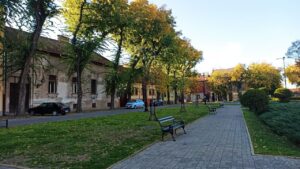The real estate market in Subotica and its influence on the city’s economy
Subotica, a picturesque city located in northern Serbia, has been experiencing significant changes in its real estate market over the past few years. As a city known for its rich cultural heritage and architectural beauty, Subotica has become an attractive destination for both domestic and international investors. The real estate sector plays a crucial role in shaping the local economy, influencing various aspects such as employment, infrastructure development, and overall economic growth. This article delves into the dynamics of the real estate market in Subotica and its broader implications for the city’s economy.
The Real Estate Market in Subotica
The real estate market in Subotica has witnessed a notable uptick in activity, driven by a combination of factors including urban development, population growth, and an increasing interest from foreign investors. The city’s strategic location near the Hungarian border makes it an appealing choice for those looking to invest in residential and commercial properties. Additionally, the local government has implemented policies aimed at facilitating real estate transactions, which has further stimulated market activity. As a result, property prices have seen a steady increase, reflecting the growing demand for housing and commercial spaces.
Residential real estate, in particular, has become a focal point for both buyers and renters. The demand for apartments and houses has surged, leading to the construction of new developments and the renovation of older properties. This trend is not only enhancing the living standards of residents but also attracting young professionals and families seeking affordable housing options. Furthermore, the rise in property values has encouraged homeowners to invest in renovations, thereby improving the overall aesthetic and functionality of the city.
Commercial real estate is also on the rise, with an increasing number of businesses setting up shop in Subotica. The city’s vibrant economy, characterized by a mix of traditional industries and emerging sectors, has created a favorable environment for commercial investments. Retail spaces, office buildings, and industrial properties are in high demand, contributing to the diversification of the local economy. As businesses flourish, they generate employment opportunities, which in turn boosts consumer spending and stimulates further economic growth.
Influence on the City’s Economy
The real estate market in Subotica has a profound impact on the city’s economy, serving as a catalyst for job creation and infrastructure development. As the demand for housing and commercial spaces rises, construction projects have proliferated, leading to the creation of numerous jobs in the construction sector. This influx of employment opportunities not only benefits those directly involved in construction but also has a ripple effect on related industries such as manufacturing, transportation, and retail. As more people find work, disposable income increases, further stimulating local businesses.
Moreover, the growth of the real estate market has prompted significant investments in infrastructure. The local government has recognized the need to enhance transportation networks, utilities, and public services to accommodate the increasing population and business activities. Improved infrastructure not only supports the real estate sector but also enhances the overall quality of life for residents. Better roads, public transportation, and amenities make Subotica a more attractive place to live and work, thereby drawing in more residents and investors.
Additionally, the real estate market contributes to the city’s tax revenue, which is essential for funding public services and development projects. Increased property values lead to higher property taxes, providing the local government with the resources needed to invest in education, healthcare, and public safety. This financial boost enables Subotica to improve its infrastructure and services, creating a positive feedback loop that further enhances the city’s appeal to potential residents and investors.
In conclusion, the real estate market in Subotica is not merely a reflection of the city’s growth but a driving force behind its economic development. The interplay between residential and commercial real estate activities has led to job creation, infrastructure improvements, and increased tax revenues, all of which contribute to a more vibrant and sustainable economy. As Subotica continues to evolve and attract investment, the real estate sector will undoubtedly remain a pivotal element in shaping the city’s future, making it a key area of interest for stakeholders and policymakers alike.


